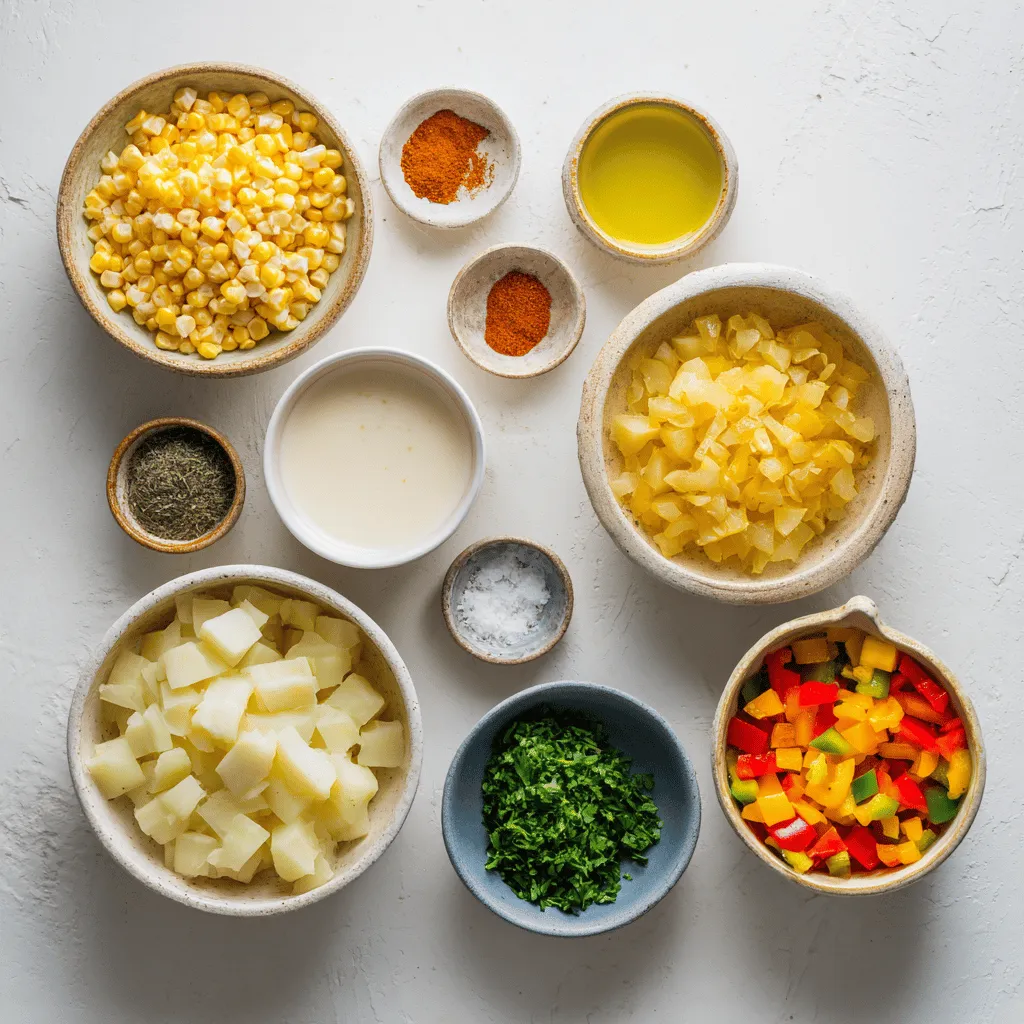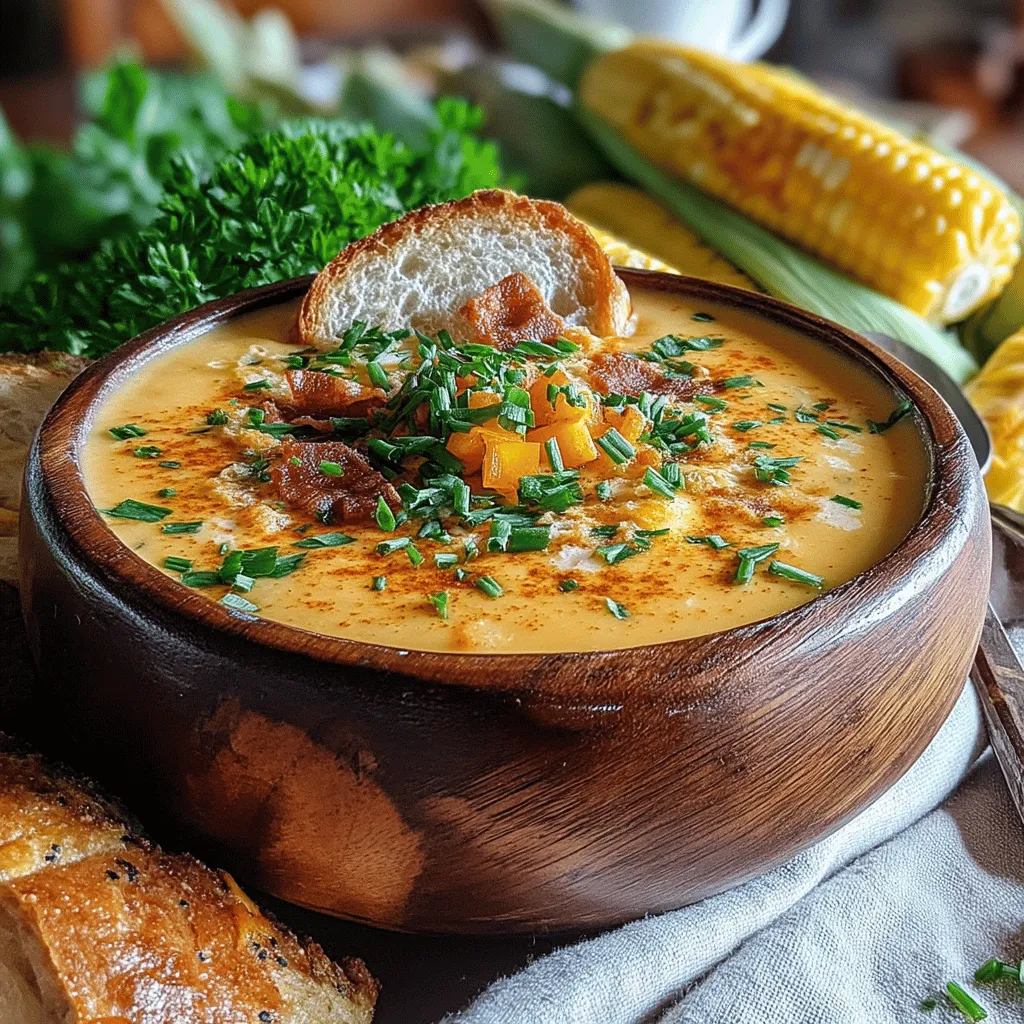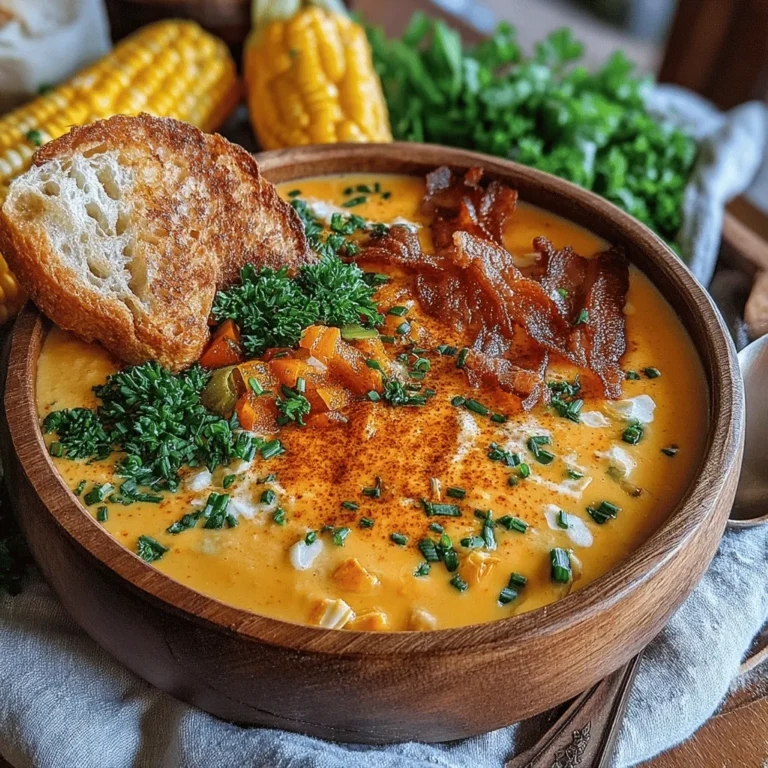Introduction
Corn chowder is a beloved comfort food that warms the soul, especially on chilly days. Its creamy texture and delightful sweetness from fresh corn make it an irresistible choice for any meal. This cozy dish not only satisfies the palate but also invites you to enjoy the simple pleasures of home cooking.
What sets this recipe apart is its rich, creamy base created with fresh ingredients, allowing for both flavor and nutrition. Plus, it’s easily customizable to suit various dietary preferences, whether you’re vegetarian, looking for a dairy-free alternative, or simply aiming to enjoy a hearty bowl of goodness.
Recipe Overview
– Total Time: 45 minutes
– Servings: 4
– Difficulty: Easy
Ingredients
– 4 cups fresh corn kernels
– 2 medium Yukon Gold potatoes, diced
– 1 medium onion, chopped
– 2 cloves garlic, minced
– 4 cups vegetable broth
– 1 cup heavy cream or coconut cream
– 1 teaspoon dried thyme
– 1 teaspoon smoked paprika
– Salt and pepper to taste
– 2 tablespoons olive oil

Instructions
1. In a large pot, heat the olive oil over medium heat. Add the chopped onion and sauté until translucent, about 5 minutes.
2. Stir in the minced garlic and cook for an additional 1-2 minutes until fragrant.
3. Add the diced Yukon Gold potatoes and fresh corn kernels to the pot. Stir to combine.
4. Pour in the vegetable broth and bring the mixture to a boil. Reduce the heat and let it simmer for 20 minutes, or until the potatoes are tender.
5. Use an immersion blender to partially puree the soup, leaving some chunks for texture. If you don’t have an immersion blender, you can carefully transfer a portion to a standard blender and puree before returning it to the pot.
6. Stir in the heavy cream or coconut cream, dried thyme, smoked paprika, and season with salt and pepper to taste. Heat through for an additional 5 minutes.
Exploring the Ingredients
Fresh Corn Kernels
– Benefits of using fresh corn vs. frozen
– Nutritional value and flavor profile
Yukon Gold Potatoes
– Why Yukon Gold is ideal for chowder
– Cooking properties and texture
Aromatics: Onion and Garlic
– Importance of sautéing aromatics for flavor
– Health benefits of garlic and onions
Vegetable Broth
– Options for broth (vegetable vs. chicken)
– Homemade vs. store-bought broth considerations
Cream Options
– Comparison between heavy cream and coconut cream
– Impact on flavor and texture
Seasonings: Thyme and Smoked Paprika
– Role of herbs and spices in enhancing flavor
– Nutritional benefits of thyme

Tips for Perfecting Your Corn Chowder
Method for Mixing and Ensuring Even Cooking
Mixing the ingredients thoroughly is crucial for achieving a well-blended corn chowder. Start by sautéing your vegetables before adding them to the pot; this technique helps to release their natural flavors, ensuring an even cook. Stir occasionally to prevent any sticking at the bottom and to allow for even heat distribution.
Importance of Texture in the Final Dish
Texture plays a vital role in the enjoyment of your chowder. The creamy base should contrast nicely with the sweet, tender corn and crunchy vegetables. Pay attention to the size of your vegetable cuts; smaller pieces will cook faster and integrate better into the soup, while larger chunks provide a satisfying bite.
Incorporating Broth and Seasonings
When adding broth, aim for a good quality vegetable or chicken stock to enhance the chowder’s flavor. Seasonings such as thyme, bay leaves, or smoked paprika can elevate the taste profile. Taste as you go to ensure a balanced flavor that complements the sweetness of the corn.
Techniques for Achieving the Right Balance of Flavors
To achieve the right balance of flavors, start with less seasoning and adjust as needed. Remember that the flavors will intensify as the chowder simmers. After the chowder reaches a simmer, taste it again and add more seasoning if necessary to suit your palate.
How to Know When the Chowder is at a Boil
A gentle boil is ideal for simmering chowder. Look for small bubbles forming around the edges of the pot. Avoid a rolling boil, as this could break down the vegetables and alter the desired texture.
Blending for Creaminess
For a smooth and creamy consistency, blending is key. You can use an immersion blender directly in the pot for convenience, or transfer to a regular blender in batches. Just be cautious, as hot liquids can expand and create a mess.
Benefits of Using an Immersion Blender vs. a Regular Blender
Immersion blenders are perfect for soups as they allow you to blend directly in the pot, saving time and reducing cleanup. They also enable you to control the level of creaminess without over-processing, which can be a risk with traditional blenders.
Tips for Maintaining the Rustic Texture
For a rustic texture, blend only half of the chowder and leave the rest chunky. This technique retains the delightful bites of corn and vegetables while ensuring the soup remains creamy.
Final Touch: Stirring in Cream
Once you’ve blended the chowder to your liking, stir in heavy cream for added richness. This step not only enhances the flavor but also contributes to the overall creaminess of the dish.
Importance of Simmering After Adding Cream
After adding cream, allow the chowder to simmer gently for a few minutes. This step helps incorporate the cream fully and allows the flavors to meld together beautifully.
Adjusting Seasoning for a Personalized Flavor
Don’t forget to adjust the seasoning after adding cream. A pinch of salt or a dash of pepper can make all the difference in achieving a well-rounded flavor profile.
Serving Suggestions
Presentation Tips for a Beautiful Serving
Serve your corn chowder in deep bowls for a cozy presentation. Garnish with fresh herbs or a drizzle of cream to elevate the dish visually and enhance the flavor.
Pairing Ideas: Crusty Bread, Crackers, or Salads
Corn chowder pairs wonderfully with crusty bread, crackers, or a fresh salad. The crunchy texture of the bread complements the creaminess of the chowder, making for a satisfying meal.
Optional Toppings for Customization
Encourage guests to customize their bowls with optional toppings such as crumbled bacon for a savory kick or a dollop of sour cream for tanginess.
Crumbled Bacon for Non-Vegetarians
For those who enjoy meat, crumbled bacon adds a delightful crunch and umami flavor to the chowder. It’s an excellent way to elevate the dish further.
Fresh Herbs for Added Flavor and Color
Sprinkle chopped fresh herbs like parsley or chives over the chowder just before serving. Not only do they add a pop of color, but they also enhance the overall flavor with their freshness.
Nutritional Profile
Overview of the Nutritional Benefits of the Chowder
Corn chowder is not only delicious but also packed with nutrients. Corn is rich in fiber and vitamins, while the addition of vegetables contributes to a well-rounded meal.
Breakdown of Calories, Fats, Proteins, and Carbohydrates per Serving
A typical serving of corn chowder contains approximately 250-300 calories, 10-15 grams of fat, 5-7 grams of protein, and 35-40 grams of carbohydrates. Be sure to adjust the ingredients based on your dietary preferences.
Discussion on Dietary Considerations (Gluten-Free, Vegetarian Options)
This corn chowder can easily be made gluten-free by using a certified gluten-free broth. It’s also a great vegetarian option, making it a versatile dish for various diets.
Cultural and Seasonal Relevance
The Role of Corn Chowder in Various Cuisines
Corn chowder has roots in many cuisines, particularly in American and Native American cooking. It showcases the versatility of corn and its ability to comfort and nourish.
How This Dish Fits into Seasonal Cooking—Ideal for Fall and Winter
This chowder is perfect for fall and winter months when comfort food is most desired. Its warm, hearty nature makes it a staple for cozy dinners.
The Comfort Food Aspect of Chowder During Colder Months
Corn chowder is synonymous with comfort. Its creamy texture and rich flavors provide warmth and satisfaction, making it an ideal choice for chilly evenings.
Conclusion
Cozy & Creamy Corn Chowder Bowls offer a delightful combination of flavors and textures that warms the heart. This recipe embodies comfort food at its finest, encouraging you to share this nourishing dish with loved ones. With its versatility, it can easily be adapted to suit various dietary needs, ensuring everyone can enjoy a bowl of this comforting chowder.


